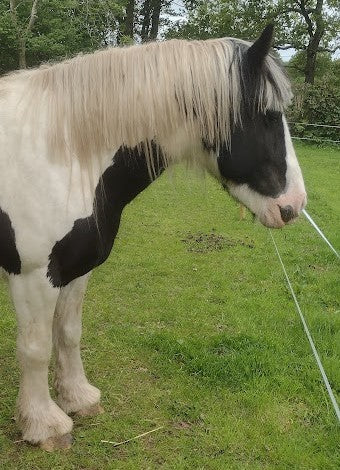
Watch out for the Grass
Grass Watch
I'm on high alert now as my little "Piggies" I mean Ponies are finding extra in the fields and so I really need to cut back on the hay and start to shut off parts of their grazing. "See Carrie looking over the fence, checking if it is on"
It's that time of year when the nights are still cold and days are mixed, we have the heating on at home still and I worry for my equines, I am tempted to keep feeding and putting rugs on.
But, they are built differently to us, there is some warmth out there when the sun comes out occasionally and the grass is starting to grow.
We do not want Laminitis. It is an evil, painful and debilitating disease.
I've been there before and causes so much damage, it is prone to coming back regularly and more severely each time, prevention is the best cure.
Any signs of your barefoot or shod horse looking footy, taking smaller strides, uncomfortable on tight turns, pulses or heat, unusual stances, lying down more often? Please, please treat as an emergency.
Top tips to reduce weight: (I'm not a vet, please always consult with yours, but this is what I do).
- Check if your horse/pony really needs that rug and/or reduce to a thinner one.
- Restrict access to grass, start closing off parts of the field to rest.
- Check the quality of your fences. Add another rung of electric tape, I now have 3, the little Houdini's likes to squeeze through. I use fence testers, newer tape, less knots and joins and look for any discharge points like tall weeds or tape touching the fence rather than an insulator to keep the zap strong etc..
- Reduce the hay little by little, week on week.
- Reduce/remove any bucket feed, check it's only high fibre, low starch, low sugar.
- Always read the bagged feed ingredients label, not just what the advertising on the front says.
- Keep up a good multi-vitamin and mineral powder or balancer. Plus salt blocks for them to help them self.
- Reduce hay and feed slowly so they are not hungry and desperate as other problems can occur then: colic, ulcers, eating anything else.
- Use small holed hay-nets to make their forage last longer.
- Split their hay ration into smaller portions and spread or move their hay-nets / feeders around their space to keep moving.
- Put in a track around the outside of the field if you can, make them move further to get the grass.
- Strip graze or whatever you can set up for your situation.
- Exercise, try to add some and increase it, try walking in hand first, lunging, long reining. (If like me they've been resting all winter).
- Clip to keep them cool if they are hairy beasts, make them work harder to stay warm.
- Add a grazing muzzle for a few hours ( although I hate the look I get and use as a last resort)
- Also as, a last resort, for the horse and for us, you could stable them for a few hours a day to monitor their food intake. But movement is key.
- If they do need to be stabled is there a way to extend the stable? i.e. a little corral of fences so that they can move in and out.
Cavallo Hoof boots and insole pads can ease the symptoms and help in the stages of recovery, as part of an ongoing management plan.
As well as using a deep supportive bedding in the stable, weighed and soaked hay, a weight loss plan and of course vet guidance and pain medications. Ems and Ppid can contribute.
Good luck and best wishes,
Louise
